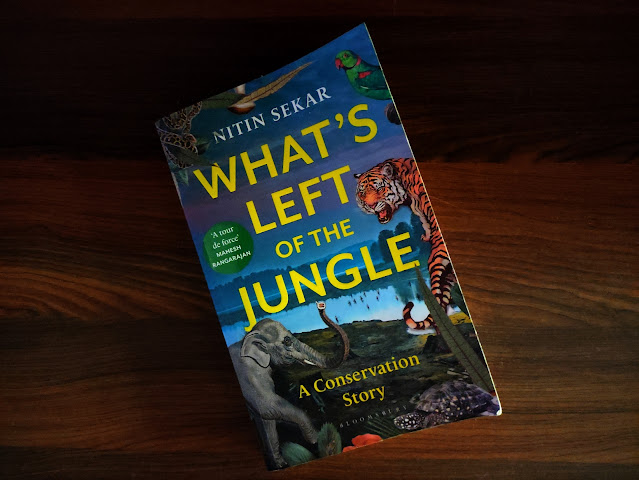What's Left of the Jungle by Nitin Sekar: a review
 |
| What's Left of the Jungle - A Conservation Story, by Nitin Sekar, published by BLOOMSBURY, 2022 |
Having visited the Himalayan foothill forests only as a tourist, and having only experienced its wildlife research and conservation aspects through research publications, What’s Left of the Jungle is a welcoming read on a protected area of West Bengal, where the author who studied seed-dispersal potential of wild Asiatic Elephants narrates his experiences and those of his resident associates of working and living in the region. This is a longish review of the book.
This book adopts a pace that is perfect if
one is to absorb the nuances of wildlife research and conservation in India.
It's real lesson I feel, is in patience - whether through the US-based writer's
journey as he circumnavigates the socioeconomic and ecological aspects of life
in a wildlife refuge or the locally-born Akshu whose perspectives are engaging
as the reader learns through his experiences right from his formative years. The
book is a carefully crafted narration from both the main characters'
perspectives around the same place.
I'm glad the author touched upon the
socioeconomic aspects because more often than not, these are either entirely
missing or barely touched upon in most wildlife books in India. The author,
instead of highlighting only the human-vs-wildlife factor or
conservationists-save-wildlife narrative – narratives that misrepresent roles
of local communities as they face the brunt of wildlife but in most instances
help in conservation and protection of wildlife – does justice by balancing
these two aspects from what are firsthand accounts of his observations and the
people he has met and worked with. However, while well-balanced, it provides
little information on the broad-conclusions of the author's research on
elephants of Buxa or if the locals understood it's significance. I wish the
interesting piece (having read Nitin’s published papers from his PhD) was a
part of this book.
I like nuances when they are teased out in
detail. While the book only gleams over major aspects of life next to a forest,
such as hunting tradition, poaching, living with venomous snakes, or the nitty-gritty of JFMs, land rights, & public understanding of government programs
available to them – perhaps for the better, in some ways – it does provide
details of dramatic events in local lives such as timber smuggling, apathy of
officials on many occasions, and addresses the elephant in the room, living
with elephants and the human-elephant conflict, most elaborately.
If I called this book a wildlife book I
mean to say this is a literary wildlife book, with the imagery painted by in the author's words of the dense and lush forests of the Himalayan foothills or of the
aftermath of human-elephant conflict. It is not hard to comprehend these events
frame-per-frame. To me, it partly feels like reading a researcher's journal.
As a blogger on topics of wildlife and environment, it works for me; it makes the
larger things taking place around at that time not only easier to comprehend
but also relatable.
What's Left of the Jungle is a title that
is mysterious and ominous. As a reader, this simple title worked for me. What
also works is the space the author focused on; it’s a protected area of around
500 sq km rather isolated from the rest of the rapidly developing country
around it, it's residents only slowly coming into the fold of the modern
civilization. The author doesn’t seem to be asking a question but reporting on
what he observes. It is up to the reader to figure out the answer: for me, it is
that of hope in the vision of Akshu, who, as a local voice, is a ray of hope
for Buxa, a park that is yet to see better days.
For me, this book is for a quiet afternoon or midnight read. I needed the quietness to feel the narrative that flows between two different timelines effortlessly. Most importantly, to get to know about life in a thickly wooded forest abutting the Himalaya, this book is a gateway to witness it as the author did: real. It's not heavy on scientific and research jargon, making it a pleasant read for a book on a challenging and less-frequently discussed subject.
Comments
Post a Comment